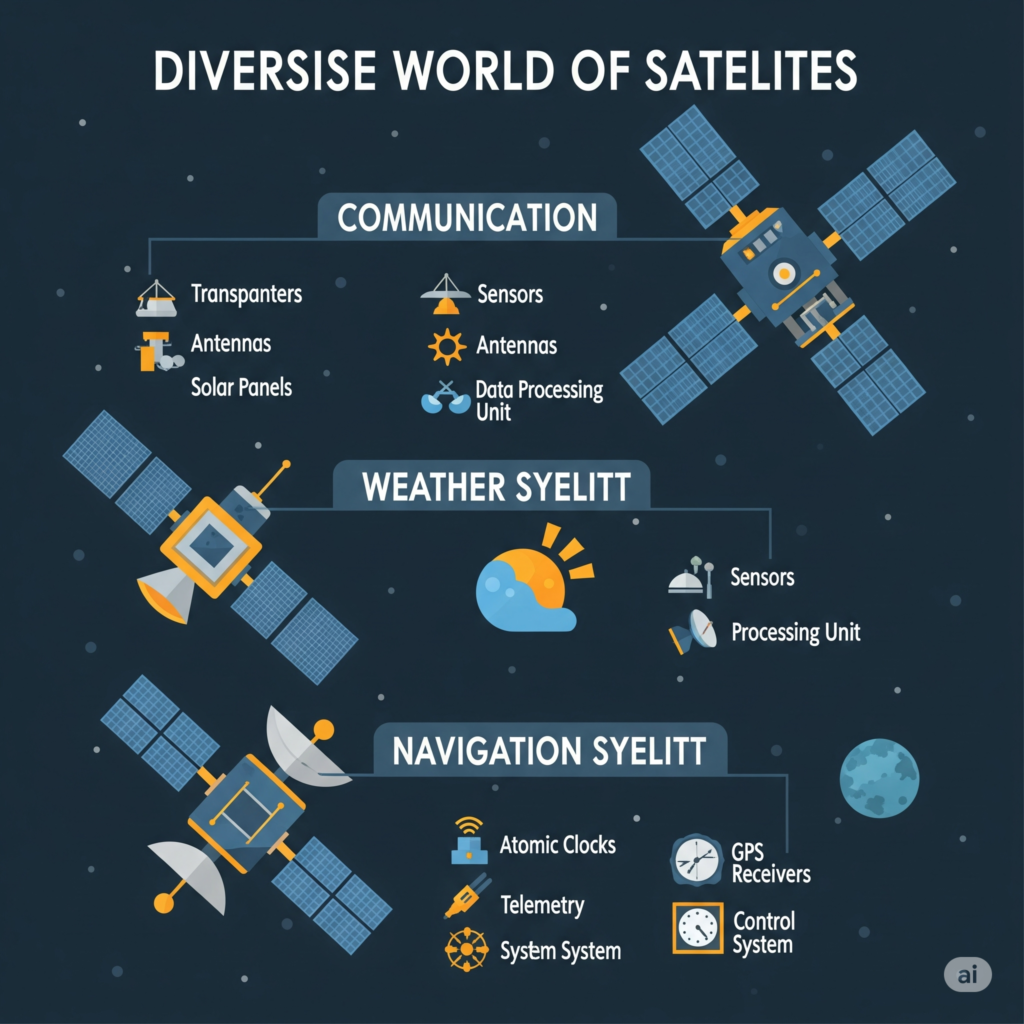More Than a Metallic Box
Every satellite you see orbiting Earth—or hear about in the news—is far more than a chunk of metal floating in space.
It’s a highly engineered machine carrying systems that collect data, send signals, take photos, and power themselves—all while operating in the harsh vacuum of space.
In this blog, we’ll break down what’s actually inside a satellite, from structural design to internal components, using real-world examples like ISRO’s Cartosat, SpaceX’s Starlink, and NOAA weather satellites.
🛰️ What Exactly Is a Satellite?

A satellite is any object that orbits a planet or celestial body. While the Moon is Earth’s natural satellite, we focus here on man-made or artificial satellites launched for:
- Communication
- Earth observation
- Navigation (like GPS)
- Scientific experiments
- Military surveillance
These satellites operate between 160 km to 36,000+ km above Earth depending on their orbit (LEO, MEO, GEO).
🧱 The Basic Architecture of a Satellite
Think of a satellite as two main parts:
- The Bus (Platform) – The support structure housing all necessary systems for operation.
- The Payload – The “mission-specific” equipment such as cameras, sensors, radar, or antennas.
Let’s look deeper into what these parts actually include.
🏗️ 1. Structure: The Skeleton of the Satellite
The frame or structure (also called the chassis) is the satellite’s body. It must:
- Be strong enough to survive launch stress
- Be light enough to not overburden the rocket
- Support thermal expansion/contraction in space
Materials: Often made from aluminum alloys, carbon composites, or titanium for lightweight strength.
Example: ISRO’s INSAT satellites use a modular structure with honeycomb panels for weight efficiency.
☀️ 2. Power Supply: Solar Panels and Batteries
Satellites don’t use petrol or coal. Instead, they rely on solar energy.
⚡ Power Components:
- Solar panels: Generate electricity from sunlight
- Rechargeable batteries: Store energy for when the satellite is in Earth’s shadow
- Power distribution units: Regulate and distribute current to systems
Fun Fact: Most satellites can survive up to 20–30 minutes of eclipse thanks to battery backups.
🧠 3. Onboard Computer (OBC): The Satellite’s Brain
The OBC runs the satellite’s operations like:
- Power management
- Data processing
- Orientation control
- Error correction
It’s like a rugged, radiation-hardened version of your smartphone’s processor—but optimized for reliability over speed.
Example: Many ISRO satellites use in-house developed processors that withstand cosmic radiation and thermal fluctuations.
📡 4. Communication System: The Messenger
Satellites constantly send and receive data. Their communication system includes:
- Transponders (for uplink/downlink)
- High-gain antennas (for targeted Earth communication)
- Low-gain antennas (for omnidirectional signals)
- Telemetry and tracking system (for mission control communication)
Types of Signals:
- RF (radio frequency)
- X-band (military)
- Ka-band (high-speed internet)
- Laser (new, ultra-high bandwidth trials)
🔄 5. Attitude Determination and Control System (ADCS)
“Attitude” in space means orientation. Satellites must know which way they’re facing to aim cameras, solar panels, or antennas.
Components:
- Gyroscopes and accelerometers: Detect motion and direction
- Star trackers: Use star patterns for orientation
- Magnetometers: Sense Earth’s magnetic field
- Reaction wheels: Rotate the satellite by spinning
- Thrusters: Make larger corrections using fuel
Example: A spy satellite must keep its camera pointed precisely at Earth targets, which demands high-accuracy attitude control.
🧪 6. Thermal Control System: Regulating Temperature in Space
Space is cold, but satellites can overheat due to constant solar radiation.
Satellites use:
- Radiators: Emit excess heat
- Insulation (MLI): Multi-layered blankets to retain or deflect heat
- Heaters: For systems that require stable warmth
- Louvers: Mechanical panels to manage radiation
Without this system, batteries could freeze or instruments could fry.
🚀 7. Propulsion System: Movement in Microgravity
Satellites aren’t stationary—they need minor orbit corrections to stay aligned or avoid space debris.
Typical Propulsion Systems:
- Chemical thrusters (Hydrazine-based)
- Electric propulsion (Ion or Hall-effect thrusters)
- Cold gas thrusters (for micro-satellites)
Example: India’s GSAT satellites use chemical thrusters for station-keeping in geostationary orbit.
🔬 8. Sensors and Instruments (Payload)
This is the “business end” of the satellite—its mission-specific tech. Examples:
- Cameras & multispectral imagers (Earth observation)
- Infrared sensors (weather or missile tracking)
- Radar & LiDAR systems (terrain mapping)
- Scientific instruments (measuring cosmic rays, solar particles, etc.)
Example: ISRO’s Cartosat satellites use high-resolution panchromatic cameras for 2D/3D mapping.
🧩 Bonus: Modular vs CubeSats vs Constellations
Modular Satellites:
- Larger, multi-purpose units
- Can include replaceable modules
- Used in deep space or complex missions
CubeSats:
- Tiny satellites (10x10x10 cm) used for quick, low-cost experiments
- Often deployed from ISS or secondary launch slots
Satellite Constellations:
- Dozens or thousands of small satellites working together (e.g., Starlink, OneWeb)
- Enable global internet or continuous Earth imaging
🧠 In a Nutshell: The Satellite’s Internal Map
Here’s a simplified table of what’s inside:
| System | Purpose |
|---|---|
| Structure | Holds everything together |
| Solar Panels & Battery | Generate and store power |
| Onboard Computer | Manage operations |
| Communication Antennas | Send and receive signals |
| ADCS | Control orientation |
| Thermal System | Regulate temperature |
| Thrusters | Adjust orbit or direction |
| Sensors/Instruments | Do the actual mission task |
🌍 Real Examples of Satellite Internals
- Starlink satellites include flat-panel antennas and krypton-fueled ion thrusters.
- NASA’s Landsat-9 includes thermal IR sensors and a near-infrared optical imager.
- ISRO’s RISAT satellites use synthetic aperture radar (SAR) to capture images day or night.
🧠 Final Thoughts: Engineering in Orbit
The next time you look at a satellite in a science video or news article, remember it’s not just a metal box. It’s a smart, autonomous robot, built to survive one of the most extreme environments known—and keep Earth connected, informed, and safe.
🌌 “Each satellite is a blend of science, survival, and precision—all silently circling above you.”








+ There are no comments
Add yours